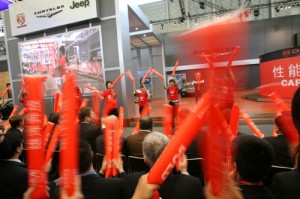
If a Chrysler-Fiat link looks to be a hard sell to U.S. taxpayers, wait until the Chinese come calling.
With a dismal financial earnings report due this week from General Motors and an equally dismal sales report due next week, speculation that GM and Chrysler are being pushed towards bankruptcy continues to circulate in Washington, Detroit and New York.
GM officials continue to insist that the automaker isn’t going to file for bankruptcy protection.
“We have considered all the options, but still believe an out-of-court process is the least risky and least expensive,” says Tom Wilkinson. GM did force its Swedish subsidiary Saab to file for bankruptcy last week and is pressuring governments from South Korea to Germany to Canada for more cash.
Chrysler LLC officials have also once again denied the automaker was preparing to file for bankruptcy at the behest of the Obama administration’s automotive task force.
“Sorry I can’t comment on the speculation. The issue in question is best left to Treasury to comment on,” says Chrysler spokeswoman Shawn Morgan. “We were asked as part of the February 17 submission to look at all scenarios.”
“As we’ve outlined, if the requisite concessions are not achieved by the government’s March 31 funding deadline, management believes the only alternative would be to immediately plan for an orderly wind down of all operations through a court-supervised liquidation. This is clearly not an alternative Chrysler would prefer,” Morgan says.
Both Chrysler and GM also are still negotiating with the United Auto Workers union on additional concessions on financing of the Voluntary Employee Benefit Association, which were set up in 2005 and 2007 to pay for retiree health care. Concessions from the union could save both companies billions, but it also puts the solvency of the fund at risk.
While Ford has not asked for government aid, it has used the deep recession in the industry to seek concessions from the union on VEBA and in other areas. A new tentative agreement gives Ford “the option” of using Ford common stock for up to 50% of the payments into the VEBA in lieu of the cash originally agreed upon, according to Joe Hinrichs, group vice president, Global Manufacturing and Labor Affairs, Ford Motor Company.
The union is attempting to use the new Ford deal to shield itself from more rigorous demands for concessions from the other two automakers. The UAW is offering similar terms to both General Motors and Chrysler LLC, sources indicate.
Both Chrysler and GM were demanding more than the 50% decrease in their cash infusions to the fund. Neither GM nor Chrysler had any comment on the new Ford-UAW agreement or how it would affect their negotiations.
Chrysler and GM last week asked for more than $21.6 billion in loans from U.S. taxpayers. Both companies are supposed to have deals with the union wrapped up by March 31.
Chrysler is also looking at other potential sources of cash.
The automaker is apparently open to the idea of selling outdated tooling and other equipment to potential buyers in China. However, the company has declined to comment on reports that surfaced in China over the weekend, suggesting that Beijing Auto might be interested in assets from the distressed automaker.
“Chrysler does not comment on rumors or speculation, nor does it confirm or disclose the nature of its private discussions,” says spokesman David Elshoff. However, the Chrysler Restructuring Plan presented to the U.S. Treasury outlines Chrysler’s plans to sell another “$300 million in non-earning assets,” he says.
Chrysler has sold and is selling a number of assets and properties, consolidating its business and reducing its operational footprint.
“We have previously confirmed that when a product life cycle ends, we will consider selling the assets that are no longer needed. Selling assets such as tooling for vehicles we no longer make has been (and will continue to be) part of our overall business strategy,” Elshoff says.
In 2007, Chrysler, then part of DaimlerChrysler, successfully sold an outmoded assembly line from its Sterling Heights, Michigan plant to the Russian carmaker, GAZ.
American Motors Corp., which merged with Chrysler in 1987, was instrumental in the creation of Beijing Auto in the early 1980s when it set up Beijing Jeep, the first successful joint venture between a western and Chinese automaker.
